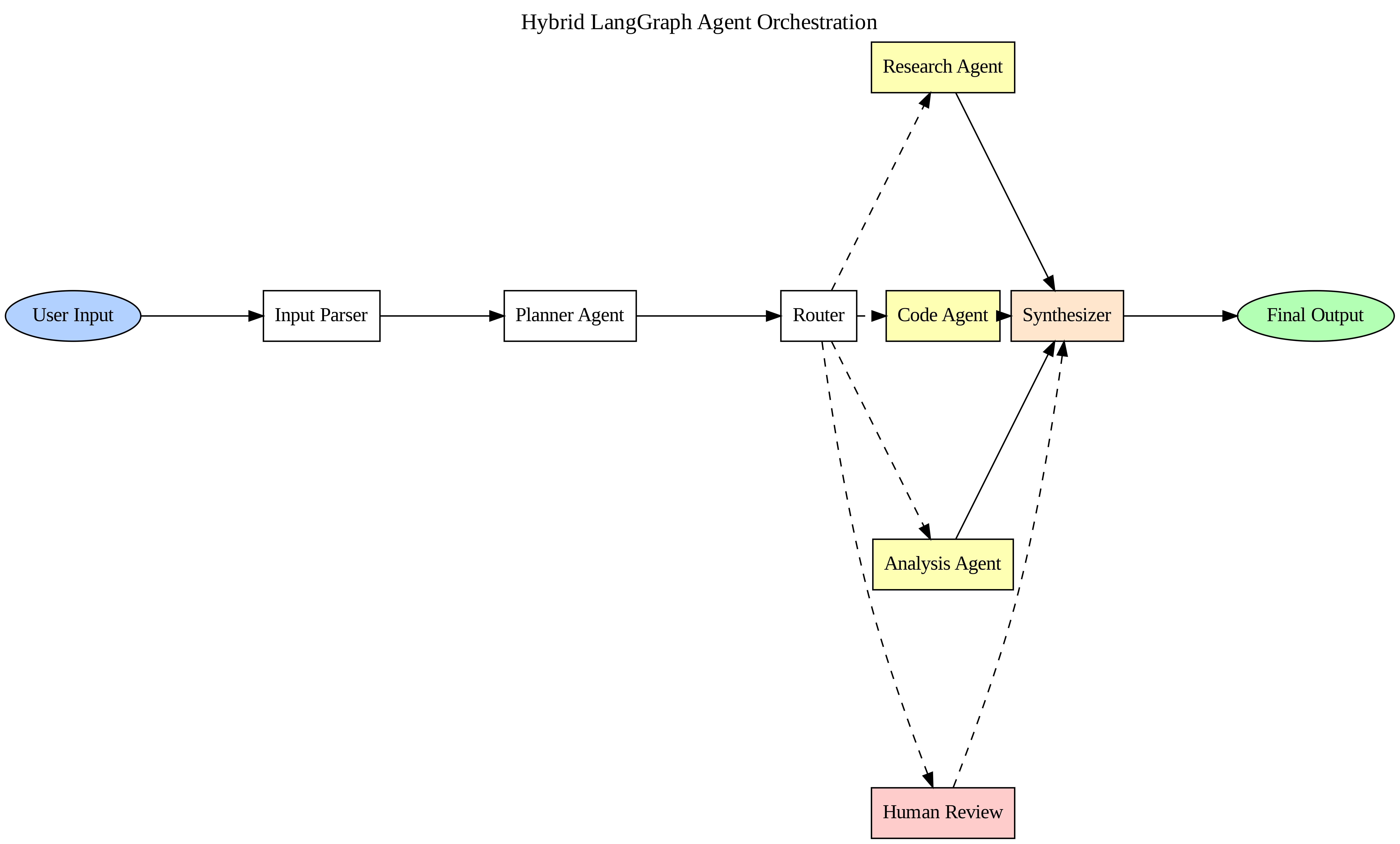Introduction
AI architecture is undergoing a fundamental shift. Instead of those monolithic, do-everything models, the real innovation is happening with composable agents - specialized AI components working together like a well-oiled machine. Think of it as the microservices revolution - but for AI.
After months of building with these frameworks, I want to share what I've learned — especially around the challenges of getting agents to communicate, manage state, and orchestrate tasks effectively.
Why Composable Agents Now?
The timing for composable agents couldn't be better, and here's why:
- Economics are driving specialization: As LLM API costs become a real consideration, specialized models that do one thing well are more cost-effective than running GPT-4 for everything.
- Agent marketplaces are emerging: We're seeing the rise of agent ecosystems where developers can publish and monetize specialized agents - creating a flywheel effect for innovation.
- Tool use has matured: The frameworks for agents to use external tools and APIs have dramatically improved, creating the foundation for truly capable agent systems.
- Multimodal is going mainstream: With models that can process text, images, audio, and video, we need orchestration systems that can handle these diverse data types.
Companies are realizing that having specialized agents that seamlessly work together isn't just a technical preference - it's becoming an economic and strategic necessity.
When Not to Use Composable Agents
Composable agents shine in complex, multimodal, or tool-integrated tasks — but they're not always the right fit. For simple Q&A bots or retrieval tasks, monolithic chains or RAG pipelines are often faster, cheaper, and easier to debug. Use composable patterns when coordination, delegation, or reasoning across tools or contexts becomes unavoidable.
This prevents you from over-engineering solutions that could be simpler. I've learned this lesson the hard way after building overly complex agent systems for straightforward tasks that could have been solved with a single prompt.
Below is a visualization of how a hybrid agent orchestration system works, with LangGraph as the backbone, conversational agents, and human-in-the-loop integration:


Example of a Hybrid LangGraph Agent Orchestration – Connection Table
This diagram and table above shows the core components of a modern composable agent system:
- LangGraph orchestration backbone: The central component that coordinates workflow from input through planning, routing, specialized processing, and synthesis
- Specialized agents: Research, coding, planning, and analysis agents that handle different aspects of tasks
- Conversational layer: Enables agents to communicate through natural language
- Human-in-the-loop integration: Allows escalation to human reviewers when needed
- Shared state: Central repository for maintaining consistent information across agents
- External resources: Knowledge bases, code repositories, and data stores that agents can access
Architectural Paradigms
At its core, composable agent systems follow principles any good software engineer would recognize:
- Modularity: Each agent does one thing and does it well
- Interface Contracts: They talk to each other through clear interfaces
- Loose Coupling: Agents don't need to know how other agents work internally
- Reusability: You can mix and match agents across different applications
Why does this matter? It lets you ship incrementally, scale just the components that need more resources, keep failures contained, and optimize specialized agents independently.
That said, orchestration introduces real complexity — especially across modalities.
Let's look at how different frameworks tackle this.
Core Framework Analysis
LangGraph
LangGraph uses a directed acyclic graph (DAG) approach - think of nodes as processing steps and edges as information highways between them.
# Create a state schema that defines what information flows through our graph
class AgentState(TypedDict):
messages: List[Dict] # Stores our conversation history
active_agent: str # Tracks which agent is currently working
status: str # Tracks execution status (running, complete, error)
# Create our workflow graph with this state schema
workflow = StateGraph(AgentState)
# Add nodes - each representing a step in our process
workflow.add_node("parser", parse_input) # First node parses user input
# ... more nodes and edges would be defined here
For complete code examples, I'd recommend checking out the LangGraph docs or this GitHub repo.
What I love about LangGraph is its fine-grained state tracking, support for conditional paths, and ability to inspect intermediate states for debugging. The downside? State management gets messy with complex graphs. But its integration with LangSmith makes tracing and evaluation much easier than it would be otherwise.
As you can see in our diagram, LangGraph forms the orchestration backbone of our hybrid system. It provides the structured flow of information between components while still allowing for conditional routing and flexible execution paths.
AutoGen
Microsoft's AutoGen takes a totally different approach - it models complex workflows as conversations between specialized agents. It's like watching experts collaborate in a chat room.
# Define specialized agents with different roles and capabilities
planner = AssistantAgent(
name="planner",
system_message="You decompose complex tasks into steps."
)
coder = AssistantAgent(
name="coder",
system_message="You implement code based on specifications."
)
# Start the conversation by asking the planner to tackle a problem
user_proxy.initiate_chat(planner, message="Develop a Python script to analyze stock market data")
What's cool about AutoGen is it doesn't try to define rigid workflows. Instead, it lets agents figure out how to collaborate through conversation. The planner might ask the coder for implementation, the coder might ask for clarification, and the executor will report back results - all through a chat-like interface.
In our diagram, this conversational approach is represented by the connections between specialized agents and the conversational layer.
CrewAI
CrewAI takes inspiration from how human teams work, with explicit roles and responsibilities. It's the most "human organization" inspired approach I've seen.
# Define specialized agents with specific roles, goals and tools
researcher = Agent(
role="Research Analyst", # Job title - affects how the agent sees itself
goal="Find comprehensive market data", # What the agent is trying to achieve
tools=[web_search_tool, data_analysis_tool], # Tools this agent can use
)
# Define concrete tasks and create a crew
investment_crew = Crew(
agents=[researcher, writer],
tasks=[research_task, report_task],
process=Process.sequential # Tasks run in sequence, not parallel
)
For business processes, CrewAI's abstractions just click - though its opinionated design can sometimes feel constraining.
Technical Challenges in Multimodal Agent Orchestration
Interface Protocol Design
This is the toughest nut to crack - how do you get agents that speak totally different languages to communicate effectively?
The challenge comes down to this: a vision agent might work with image tensors and output bounding boxes, while a language agent processes tokens and outputs parsed intents. How should they talk to each other?
# The challenge: How do we connect these systems?
# Option 1: Translation layer between agents
translated_vision_results = vision_to_language_translator(detection_results)
# Option 2: Common representation (like a scene graph)
scene_graph = vision_agent.to_scene_graph(detection_results)
You're constantly balancing keeping information intact versus useful abstraction and processing efficiency versus rich representations.
In the diagram above, you can see how specialized agents connect to both the orchestration layer and external resources - this is where interface design becomes critical for enabling smooth data flow.
State Management Complexity
When you mix modalities, state management gets wild:
- Different modalities update at wildly different rates (video at 30fps vs. conversation turns)
- Some agents need short memory, others track long-term context
- Keeping state consistent across distributed agents is a nightmare
- Agents often have incomplete information about the overall system
After many painful debugging sessions, I've found these strategies work best:
- Organize state hierarchically with different update frequencies
- Use event-driven architecture for state updates
- Version your state for distributed consistency
- Send differential updates to minimize network overhead
- Use attention mechanisms to focus on relevant state
The shared state component in our diagram highlights this critical aspect - all agents need access to a consistent view of the system state, despite operating at different timescales and with different information needs.
Coordination Pattern Selection
Different coordination patterns have real trade-offs:
- Hub-and-spoke (Centralized Coordinator)
- Pros: Clear control flow, easier debugging
- Cons: Potential bottlenecks, single point of failure
- Example: AutoGen's user proxy agent as coordinator
- Pipeline (Sequential Processing)
- Pros: Dead simple to implement, clear data flow
- Cons: Limited parallelism, rigid structure
- Example: Basic LangGraph sequential chains
- Hierarchical (Multi-level Delegation)
- Pros: Scales to complex tasks, enables abstraction
- Cons: Complex coordination, possible communication overhead
- Example: CrewAI's process hierarchies
In my experience, the best pattern varies across your system. I typically use hub-and-spoke for coordinating high-level goals, with pipelines for well-defined subtasks.
The diagram illustrates a hybrid approach - a centralized orchestrator (hub-and-spoke) connects to specialized agents that can operate in parallel, while maintaining overall workflow coordination.
Critical Gaps in Current Frameworks
While these frameworks show tremendous promise, several important challenges remain unsolved:
Security and Sandboxing
Most agent frameworks lack robust security mechanisms:
- Limited isolation between agents (vulnerabilities in one affect others)
- Inadequate permission models for external API access
- Insufficient monitoring for malicious or unexpected behaviors
- Minimal defense against prompt injection attacks
AutoGen takes a step in the right direction with Docker-based sandboxing for code execution, but we need similar protections across all aspects of agent systems.
Evaluation Challenges
Determining when an agent system is "good enough" remains incredibly difficult:
- Traditional metrics like accuracy don't capture emergent behaviors
- Test coverage is hard to define - what constitutes a representative test set?
- Evaluation costs can exceed development costs for complex systems
- Different stakeholders have conflicting quality criteria
As these systems grow more complex, we need much better evaluation frameworks that can assess both component-level performance and system-level behavior.
Long-term State Management
Current frameworks struggle with long-running state:
- Most assume short-lived interactions rather than persistent agents
- Limited support for efficient state persistence and retrieval
- Poor handling of state corruption and recovery
- Memory management becomes exponentially harder as context grows
LangGraph's state management is promising but still doesn't fully solve the challenges of long-running, stateful agent systems.
Observability and Debugging
You can't fix what you can't see - observability is crucial. Traditional debugging approaches fall short, and you need specialized techniques:
- State inspection checkpoints: Capture system state at critical points
- Component isolation testing: Verify individual agents independently
- Prompt failure analysis: Find weaknesses in LLM agent instructions
- Golden dataset evaluation: Compare outputs against known-good examples
I've found LangSmith invaluable here - its tracing and evaluation capabilities make it possible to understand what's happening across complex workflows:
# This sets up tracing for our agent workflow
with client.trace("multimodal_agent_workflow") as trace:
# Run our workflow normally
result = agent_workflow.invoke({"input": user_query})
This simple integration gives you a full trace of everything that happened in your workflow - which agents were called, what prompts were used, what responses came back, and how long each step took. It's like having a flight recorder for your AI system.
Emerging Patterns and Best Practices
Progressive Reasoning Frameworks
For complex reasoning tasks, I've found explicit multi-step reasoning approaches work best:
def reason(self, problem, context):
# Step 1: Break the problem into manageable sub-questions
sub_questions = self.decompose(problem)
# Step 2: Answer each sub-question independently
# ... more steps in the reasoning process
This approach gives you transparent reasoning steps you can debug, natural checkpoints for human validation, and specific areas to target for improvement.
Human-in-the-Loop Integration
Modern frameworks increasingly support human integration through patterns like confidence-based escalation (only ask humans when uncertain), async review queues that don't block operations, and guided interfaces for efficient human input.
def process_with_human_oversight(input, confidence_threshold=0.8):
# First attempt to process automatically
result, confidence = ai_system.process(input)
if confidence < confidence_threshold:
# Below threshold, escalate to human
human_task_id = task_queue.add_task(...)
The key is making human integration feel natural and non-disruptive - both for the human and the system.
As shown in our diagram, human reviewers connect to the system through dedicated channels, allowing experts to intervene when automated systems are uncertain or need guidance.
Framework Selection Criteria
When choosing a framework, I evaluate based on:
- Workflow Complexity: How complex are the interactions between agents?
- Customization Depth: How much can you tweak the system?
- Learning Curve: How hard is it to get started?
- Production Readiness: Is it stable enough for real use?
- Multimodal Support: How well does it handle different modalities?
- Development Speed: How quickly can you build?
- Observability: How easily can you debug?
- Resource Efficiency: How efficiently does it use compute?
My current preference? LangGraph for complex production systems (as shown in our diagram), CrewAI for rapid prototyping, and AutoGen when human integration is critical. But the space is evolving rapidly!
Future Directions
Self-Adaptive Architectures
The next frontier is systems that optimize their own architectures - selecting the right agents and coordination patterns based on the task and learning from past executions.
Emerging Standardization Efforts
We're finally seeing standardization in agent communication protocols, evaluation benchmarks, and integration interfaces. These efforts will be crucial for the ecosystem to mature beyond proprietary implementations.
Hybrid Orchestration Approaches
The future will likely combine strengths from different paradigms:
- Graph-Conversation Hybrids: Structured graphs with conversational interfaces
- Centralized-Distributed Orchestration: Central planning with distributed execution
- Model-Centric and Tool-Centric Approaches: Balancing LLM capabilities with specialized tools
The diagram and table above illustrates this hybrid approach - using LangGraph for structured workflow with a conversational layer for agent-to-agent communication, and both centralized orchestration and distributed execution.
Conclusion
Composable agent orchestration is where the real innovation is happening in AI system design. Yes, it introduces challenges in orchestration, communication, and state management - but the benefits of building with specialized components far outweigh the costs.
Each framework we've discussed offers a unique approach with distinct trade-offs. Success in this space comes from understanding both the technical foundations and your specific problem domain. As these frameworks mature, composable agents will increasingly become the default approach for building sophisticated AI systems that can tackle real-world challenges.
The frameworks are promising but still have critical gaps in security, evaluation, and long-term state management. Addressing these gaps will be essential for enterprise adoption.
What are you building with composable agents? I'd love to see how others are tackling orchestration, coordination, and hybrid design in 2025, please feel free to reach out at nlpvisionio@gmail.com.
References
- LangGraph: github.com/langchain-ai/langgraph
- AutoGen: github.com/microsoft/autogen
- CrewAI: github.com/joaomdmoura/crewAI
- LangSmith: smith.langchain.com













